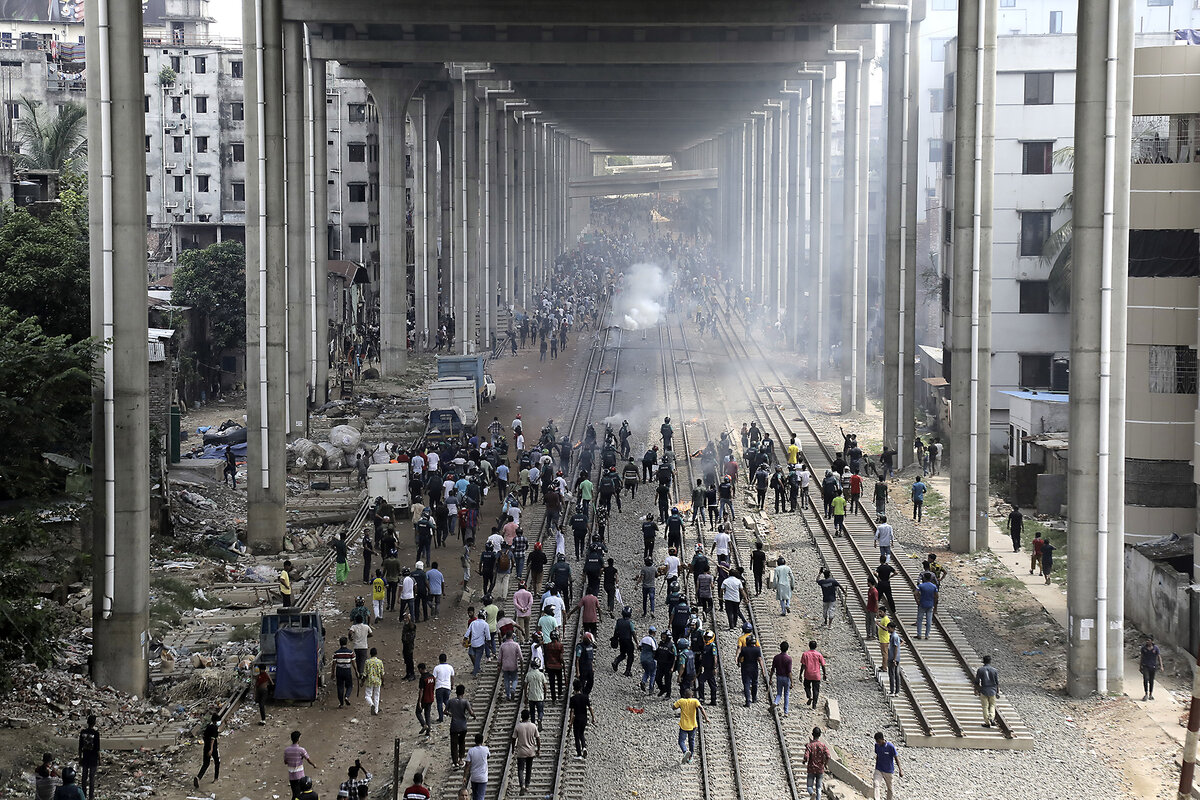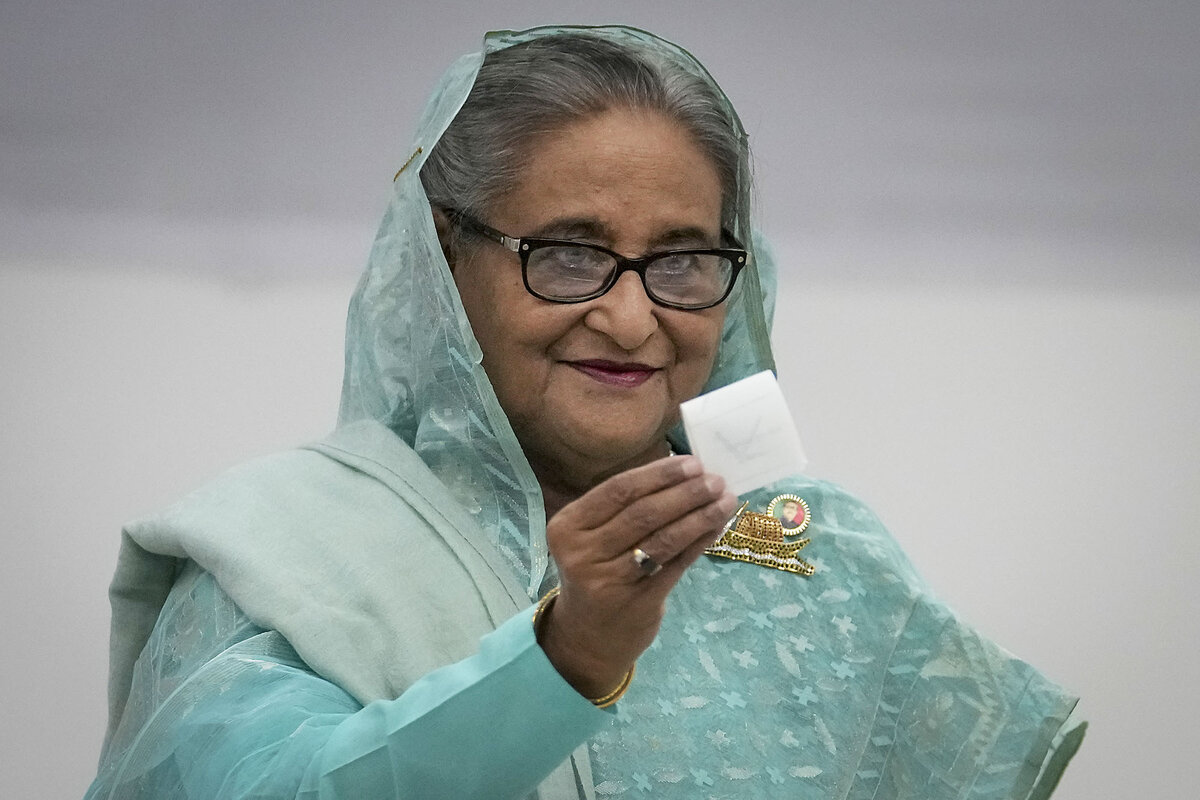Bangladeshi youth bore the brunt of last week’s violent protests. They want accountability.
Loading...
| Dhaka, Bangladesh
Bangladesh’s relatively short history has been dominated by fights for independence, democracy, and economic advancement. And now Prapti Taposhi, an economics student at Jahangirnagar University, is one face of its newest struggle: for fairness.
She was among the first students to take to the streets this July in Dhaka, the Bangladeshi capital, to protest government job quotas for veterans of the country’s 1971 war for independence and their descendants.
But as the demonstrations grew, so did violence against protesters – and Ms. Taposhi’s own sense of injustice.
Why We Wrote This
Bangladeshis are reeling from one of the most violent weeks in their country’s recent history. At the center of the chaos are young people striving to be heard.
There have been nearly 200 deaths reported since July 16 – including three of Ms. Taposhi’s close friends – marking one of the most violent weeks in the country’s history. When the government responded to the chaos by shutting off the internet, deploying soldiers, and imposing a nationwide curfew, an outraged Ms. Taposhi led other young women through the streets by burning torch.
“The protests against inequality are increasing day by day,” she says, her words laced with both fear and anger, and her wrist bandaged from an injury sustained during a demonstration. “The peaceful, student-centric, and apolitical protest has evolved into a mass movement against autocracy.”
Against the backdrop of a dearth of economic opportunities for young people, these protests are, in some ways, a generational pushback against the sacrosanctity of Bangladesh’s founding national narrative. But the movement has come to transcend generations, and grown well beyond a policy question.
Saad Hammadi, policy and advocacy manager at the Balsillie School of International Affairs in Waterloo, Ontario, says it is now fueled by anger at inflation and cost of living, corruption, clampdowns on freedom of expression, and other autocratic tendencies of the government of Prime Minister Sheikh Hasina.
“This is a protest for fairness. It’s a protest for transparency, and for accountability,” he says.
Root of unrest
The quota system was introduced in 1972 by Sheikh Mujibur Rahman, father of Prime Minister Hasina and the architect of modern Bangladesh. It set aside 30% of government jobs for “freedom fighters,” as well as 10% for victimized women and 40% for underprivileged groups. It was extended in 1997 and 2010 to include children and grandchildren of the veterans – leading to perceptions that the quota system was perpetuating an elite class.
In 2018, students took to the streets demanding reform. The government abolished the system. Then in June 2024 the High Court declared the abolition of quotas illegal, sparking a new wave of protests that culminated in a massive demonstration July 1. A week later, protesters – who had gained the support of the main opposition party – clashed with members of the student wing of the ruling party.
On its face, the protests are about jobs. To much fanfare, Bangladesh is on track to graduate from the United Nation’s Least Developed Countries list in 2026. But not everyone has benefited. Young people face an unemployment rate of 12.5%, three times the overall rate, and the reinstallation of quotas generated resentment about an unequal distribution of wealth.
The protests, initially peaceful, turned violent on July 14 when Ms. Hasina criticized students as the “descendants of Razakar,” a derogatory term that refers to people who supported the Pakistani military during the Bangladesh Liberation War. “If the grandchildren of freedom fighters don’t get the quota, then will the grandchildren of Razakars get it?” she said.
For Ms. Taposhi, being dismissed as a “Razakar” was deeply insulting, and many young people are weary of the politicization of Bangladesh’s independence movement.
“I think the resentment of the young generation is how the government creates this divide of ‘us versus them,’ and how the government defines love for the country,” says Mr. Hammadi. “To build love of country, it is important to listen to the people, create room for them to cherish the country’s history and opportunities that a state can offer. Instead we’ve seen a lot of young people have to move out of the country for better opportunities.”
On July 18 and 19, several government buildings were vandalized, with two metro stations set fire, as well as a major data center, the headquarters of the country’s largest broadcaster, and others. The student protesters, for their part, have denied responsibility for the vandalism. Security forces were seen using sound grenades, tear gas, and rubber bullets to contain the crowds.
These are not the first protests that Ms. Hasina has faced. In 2018, protests over quotas and a student-led march for road safety dogged the government. In 2020, several issues including the government’s handling of violence against women pushed Bangladeshis to the streets. Many of the same students marching today, including Ms. Taposhi, participated in those protests. But the current wave of demonstrations is one of the biggest and most deadly.
“Violence always gets escalated with ignorance and arrogance,” says Professor Manosh Chowdhury from the Department of Anthropology at Jahangirnagar University. “[This] government was always arrogant in dealing with the students – during the quota movement and road safety movement in 2018, too.”
Return to normalcy?
On Sunday, the Supreme Court ruled that quotas for descendants of “freedom fighters” must be rolled back from 30% to 5% – a victory for protesters. The internet was also partially restored this week, and though schools remain closed, signs of normal life have returned to Dhaka’s streets. Now, protesters are demanding the government face the consequences for the deadly unrest, and stop the widespread arrests of activists and opposition leaders.
“The state killings and subsequent violence were completely avoidable,” says Salim Reza Newton, a political analyst and senior faculty in the Department of Mass Communication and Journalism at the University of Rajshahi. “However, a totalitarian government often loses the ability to think rationally and calmly, especially when confronted with a mass protest that carries a seemingly hidden spirit of challenging the regime.”
Michael Kugelman, director of the South Asia Institute at the Wilson Center, agrees that the movement shows a growing disconnect in Bangladesh between the government and the public.
“The very moment the government cracked down hard, the entire dynamic took on a different dimension,” he says. “It became a large anti-government movement focused around issues of state repression and, more broadly, autocracy.”
It is unclear how transparently or thoroughly Ms. Hasina’s government will respond to protesters’ demands. On Wednesday, authorities said the government had formed a committee to investigate the events of the past week – including determining official casualty figures – but this may not satisfy protesters.
Bangladeshi youth, who bore the worst of the violence, say they will not step down.
“It was possible to have a talk and have a peaceful solution before all the blood was shed,” says Ms. Taposhi. “This autocratic government now only has the disgust of young people. The way people saw unarmed students and civilians being killed by the armed law enforcement agencies … this government can never regain the trust, support, or respect of the Bangladesh people.”
Sara Miller Llana contributed reporting from Toronto.










